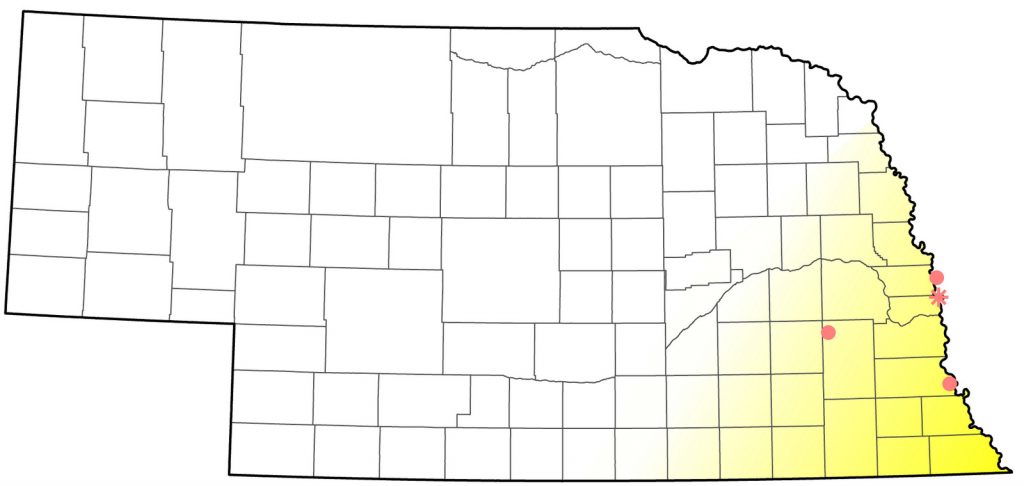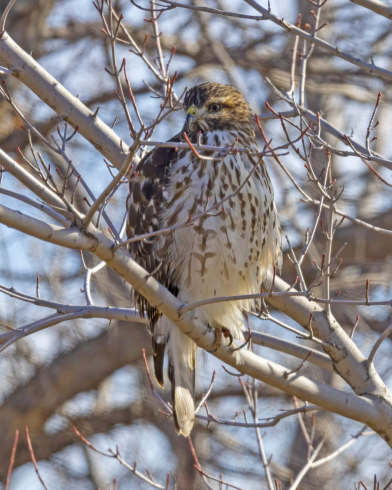Buteo lineatus lineatus
Status: Increasing. Rare regular resident southeast, rare casual elsewhere.

Documentation: Specimen: UNSM ZM12519, 15 Jan 1941 Fontenelle Forest, Sarpy Co.
Taxonomy: Five subspecies are recognized (AviList 2025): alleni of south-central Texas to North Carolina and northern Florida, extimus of south Florida and the Florida Keys, texanus from south Texas to southeast Mexico, elegans from southern Oregon to Baja California, and lineatus of eastern North America.
It has been proposed based on genetic analyses (Barrowclough et al 2019, Gill et al 2024) that the five subspecies be treated as three full species: California Red-shouldered Hawk (elegans), Florida Red-shouldered Hawk (extimus), and Red-shouldered Hawk (lineatus, alleni, texanus).
Nebraska breeders are presumed lineatus (Dykstra et al 2020).
Resident: Although there is no information such as banding data to confirm that breeding birds in Nebraska are resident, Dykstra et al (2020) show that the species is resident north in the Missouri River Valley to extreme southeast Nebraska. Although data in eBird show no major seasonal shifts in number of reports, there are fewer in summer, possibly because this species is harder to locate in leafed-out woodlands during the breeding season. Nevertheless, breeding and summer reports are increasing, suggesting a northward shift in the breeding range and a consequent increase in numbers of resident Red-shouldered Hawks (Dykstra et al 2020).
Reports away from the southeast have also increased in recent years as this species and Broad-winged Hawk, also a forest hawk, have expanded their ranges westward in major riparian corridors, although such expansion by Red-shouldered Hawk is far less extensive. There are about 39 reports north and west of a line from Burt to Jefferson Cos, 33 of these since 2000. From Mar-May 2025 about 18 Red-shouldered Hawks were reported.
Breeding records are limited to extreme southeastern Nebraska, in Lancaster, Otoe, Douglas, and Sarpy Cos (Ducey 1988). Bruner et al (1904) described the species as “not uncommon” along the Missouri River bluffs and nesting during this time was reported, albeit without details, by Bruner (1901) from Omaha, Steven’s Creek near Cheney (now part of Lincoln), and Nebraska City. Carriker (1900) considered the species “quite rare” in Otoe County but did describe finding a nest in a wooded area along Camp Creek about 12 miles south of Nebraska City. A nest was observed near Carter Lake, Douglas Co, 13 Apr-10 May 1959; this nest was abandoned although followed by possible renesting nearby 18 May-29 Jun; no evidence of successful breeding was noted, possibly because of crowds observing two separate human drownings at the lake (Cortelyou 1959).
There were no other nesting records away from Fontenelle Forest, Sarpy Co until 2009 (see below). Fontenelle Forest was the most consistent location for breeding activity for many years; Red-shouldered Hawks nested somewhat regularly throughout the 20th century. Nesting there recommenced in 1989 after having last been reported in 1964 (Cortelyou 1965), with more recent activity limited to a single pair, but has not been reported since 2000. Of interest, however, were sightings of single birds 27 Mar-16 Apr 2009, and a pair was in the area of Fontenelle Forest in 2013, seen circling there 30 Jun, and nearby over Bellevue 14 Jul. A pair over Omaha 2 Aug 2015 may have been based at Fontenelle Forest. Nests at Fontenelle Forest have been located both on wooded upland slopes and the floodplain. Breeding activity, including courtship, has been observed as early as late Jan and fledging on 6 and 15 Jun. The only recent record for Fontenelle Forest was of an immature there 1 and 11 May 2024.
There are several reports suggestive of breeding in Lancaster Co. After several sightings of single birds in 2008 in the Pawnee Lake area, two birds were seen for the first time 9 Mar 2009 and breeding was confirmed with the discovery of a pair tending a nest 30 feet up in a green ash 30 Mar; two chicks were present 9 May, and four birds were seen 25 Jun. However, the chicks may have been predated, as the adults apparently deserted the area after 26 Jun (Silcock 2009). After about 15 years, breeding likely occurred again at Pawnee WMA; a series of sightings there 1 Mar-6 May 2024 included a bird carrying possible nest material 17 Apr. One adult was present 17 Jun 2025. At Pioneers Park, an adult was seen 5 Mar 2024, and was joined by a one-year-old 12 Apr; this pair was present at least though 7 Nov. A California study found about 10% of Red-shouldered Hawk pairings involve a yearling and nearly all of these were females (Wiley 1975); these pairings likely occur more frequently in “depleted or expanding populations or when not otherwise density limited” (Tordoff and Redig 1997).
An apparently new nesting site was at Stanton Lake, Richardson Co, where 1-2 birds were present 14 Mar to at least 24 May 2024, including nest-building 17 Apr, an adult carrying food to the nest 17 May, and two adults tending two nestlings 10 Jun.
Additional reports suggestive of breeding are all from the east. Northernmost are reports are from Thurston and Dakota Cos: two were in Thurston Co at Ashford Scout Camp 11-13 Jun 2006, 23 Feb 2013, and 5 Aug 2015, and a single was at Basswood Ridge WMA, Dakota Co 21 Jul 2020. Sightings at Crystal Cove, Dakota Co 19 Aug-30 Nov 2023, including two birds interacting 21 Aug, were suggestive. Singles were at Ponca SP, Dixon Co 9 May 2024 Snyder’s Bend, Dakota Co 9 Sep 2024, and at 575 Ave, Cedar Co 27 Aug 2024. There were reports from Cass Co 8 Jun 1989, 6 Jun 1990, and 18 Aug 1991, but none since. A juvenile possibly accompanied by an adult was at Indian Cave SP, Richardson Co 29 Jul 2009; oddly, breeding has not been proven at this seemingly suitable location. Breeding may occur at Rose Creek WMA, Jefferson Co; in 2016, one was recorded 3 Jun; very vocal birds were there 27 Jul 2016 and again 11 Jul 2017.
Since 2020 there has been an increasing number of sightings in several southeastern counties without breeding evidence, including Saunders, Douglas, Sarpy, Seward, Lancaster, Gage, Otoe, Johnson, Pawnee, Nemaha, and Richardson, as well as seven reports in 2023 west to Buffalo Co through 30 Nov, and one as far west as Dundy Co; these reports continue the apparent, albeit slow, westward push of this species in the state.
Continuing to consolidate its presence in the southeast, there were reports fin winter 2024-2025 from no fewer than 12 locations (eight in Lancaster Co) involving at least 14 individuals, including sightings of two at Plum Creek Trail, Seward Co 11 and 13 Jan and at Pawnee Lake 20 Jan-1 Feb. A mix of adults and juveniles was reported; interestingly, both distributional outliers were juveniles, in Harlan Co 16 Dec and in Dodge Co 18 Dec-1 Jan.
Reports in Aug away from known breeding locations may be recently fledged juveniles or non-breeding immatures, although very small numbers of migrants may occur. The Hitchcock Nature Center Hawk Watch, Pottawattamie Co, Iowa has recorded an average of four birds per fall, occurring mid-Aug through late Nov (http://hawkcount.org).
-
- Breeding Phenology:
- Courtship: late Jan
- Nest building: 20 Mar-17 Apr
- Eggs/incubation: 1 Mar- 17 May (Mollhoff 2022)
Nestlings: 30 Apr-10 Jun - Fledglings: 6-15 Jun
Winter sightings have increased in recent years, and many may indicate potential breeding locations to be checked in the following breeding season; five were reported in the southeast in 2021, with an apparent adult westerly in Adams Co, and four in winter 2021-2022, one northerly at Red Fox WMA, Stanton Co 5 Feb. In winter 2022-2023, 12 were reported, including singles Cuming Co 5 Feb and Valley Co 18 Feb. Similarly in 2023-2024 at least 12 were reported, including vagrant immatures in Harlan Co 14 Dec, Kearney Co 15 Dec, and Dakota Co 3-31 Dec.
That edge of range reports are increasing is supported by first or second CBC records in 2023-2024 at BOL-Seward, Harlan County Reservoir, and Kearney.
An albino specimen from Loomis, Phelps Co 12 Aug 1954 is HMM 28383.
Images
Abbreviations
HMM: Hastings Municipal Museum
RA: Recreation Area
SP: State Park
UNSM: University of Nebraska State Museum
WMA: Wildlife Management Area (State)
Literature Cited
AviList Core Team, 2025. AviList: The Global Avian Checklist, v2025. https://doi.org/10.2173/avilist.v2025.
Barrowclough, G.F., J.G. Groth, W.M. Mauck, and M.E. Blair. 2019. Phylogeography and species limits in the red‐shouldered hawk (Buteo lineatus): Characterization of the Northern Florida Suture Zone in birds. Ecology and Evolution, 9: 6245-6258.
Bruner, L. 1901. Birds that nest in Nebraska. Proceedings Nebraska Ornithologists’ Union 2: 48-61.
Bruner, L., R.H. Wolcott, and M.H. Swenk. 1904. A preliminary review of the birds of Nebraska, with synopses. Klopp and Bartlett, Omaha, Nebraska, USA.
Carriker, M.A., Jr. 1900. Some notes on the nesting of the raptors of Otoe County. Proc. Nebraska Ornithologists’ Union 1: 29-34.
Cortelyou, R.G. 1959. Douglas County Notes. NBR 27: 31.
Cortelyou, R.G. 1965. Nesting Report, 1964. NBR 33: 9-13.
Ducey, J.E. 1988. Nebraska birds, breeding status and distribution. Simmons-Boardman Books, Omaha, Nebraska, USA.
Dykstra, C.R., J.L. Hays, and S.T. Crocoll. 2020. Red-shouldered Hawk (Buteo lineatus), version 1.0. In Birds of the World (A. F. Poole, Editor). Cornell Lab of Ornithology, Ithaca, NY, USA. https://doi.org/10.2173/bow.reshaw.01.
Gill, F., D. Donsker, and P. Rasmussen (Eds). 2024. IOC World Bird List (v 14.2). Doi 10.14344/IOC.ML.14.2. http://www.worldbirdnames.org/
Mollhoff, W.J. 2022. Nest records of Nebraska birds. Nebraska Ornithologists’ Union Occasional Paper Number 9.
Silcock, W.R. 2009. Summer Field Report, June-July 2009. NBR 77: 94-110.
Tordoff, H.B., and P.T. Redig. 1997. Midwest Peregrine Falcon demography, 1982-1995. Journal of Raptor Research 31: 339-346.
Wiley, J.W. 1975. The nesting and reproductive success of Red-tailed Hawks and Red-shouldered Hawks in Orange County, California. Condor. 77: 133-139.
Recommended Citation
Silcock, W.R., and J.G. Jorgensen. 2025. Red-shouldered Hawk (Buteo lineatus). In Birds of Nebraska — Online. www.BirdsofNebraska.org
Birds of Nebraska – Online
Updated 24 Aug 2025



